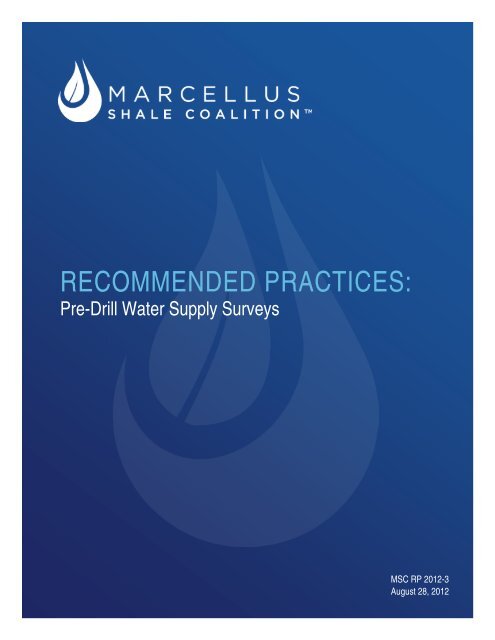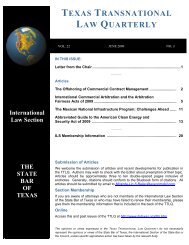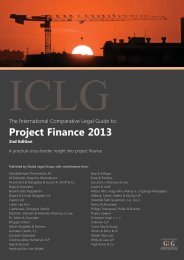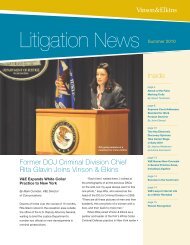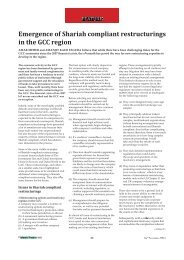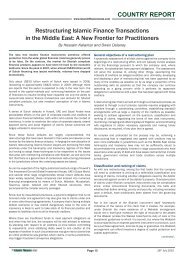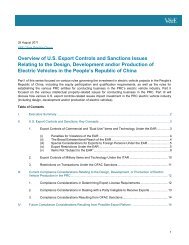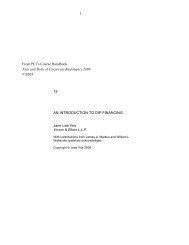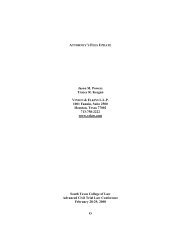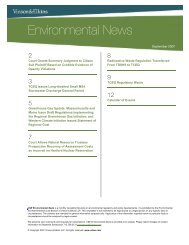MSC Recommended Practices for Pre-Drilling Sampling
MSC Recommended Practices for Pre-Drilling Sampling
MSC Recommended Practices for Pre-Drilling Sampling
You also want an ePaper? Increase the reach of your titles
YUMPU automatically turns print PDFs into web optimized ePapers that Google loves.
RECOMMENDED PRACTICES:<strong>Pre</strong>-Drill Water Supply Surveys<strong>MSC</strong> RP 2012-3August 28, 2012
RECOMMENDED PRACTICES FORPRE-DRILL WATER SUPPLY SURVEYSOverviewThe Marcellus Shale Coalition is recommending that operators conduct a pre-drill water surveyon identified water supply sources within a given area of the well pad surface location, as isrequired by the relevant regulatory agency.Water supply sources such as wells, springs and ponds should be evaluated prior to earthdisturbance <strong>for</strong> site construction or prior to spud. Consideration should also be given tosampling water supply sources that are not currently in use.Water samples should be obtained by a properly trained and experienced independent third partyand in accordance with applicable state and federal regulations and requirements. <strong>Sampling</strong> shallbe conducted as close to the water supply source as is practical.Surveying and sampling should be conducted with the landowner's consent. If the landowner orwater purveyor refuses to allow the operator access to conduct the water sampling, the operatorshould issue notice to the landowner or water purveyor by certified mail, with a copy to theregulatory agency, that access was refused.Water samples should be analyzed by a certified laboratory using EPA SW-846 methods ordrinking water methods. A list of test parameters appears in Section 4.2 of the <strong>Recommended</strong><strong>Practices</strong> <strong>for</strong> <strong>Pre</strong>-drill Water Supply Surveys.A report of the analytical results should be provided to the regulatory agency and to the watersupply owner or resident if applicable. Operators should consider including in reports referencesthat the homeowner may use to interpret the analytical data, such as publicly available guidancedocuments from regulatory agencies.©2012 The Marcellus Shale Coalition. Unauthorized reproduction prohibited.
RECOMMENDED PRACTICES FORPRE-DRILL WATER SUPPLY SURVEYS<strong>Pre</strong>faceThis document provides general guidance on recommended practices <strong>for</strong> the subject(s)addressed. It is offered as a reference aid and is designed to assist industry professionals inimproving their effectiveness. It is not intended to establish or impose binding requirements.Nothing herein constitutes, is intended to constitute, or shall be deemed to constitute the settingor determination of legal standards of care in the per<strong>for</strong>mance of the subject activities. The<strong>for</strong>egoing disclaimers apply to this document notwithstanding any expressions or terms in thetext that may conflict or appear to conflict with the <strong>for</strong>egoing.1.1 <strong>MSC</strong> Guiding PrinciplesSection 1IntroductionWe, the members of the Marcellus Shale Coalition, embrace and operate by the followingguiding principles:• We provide the safest possible workplace <strong>for</strong> our employees, our contractors, and in thecommunities in which we operate;• We implement state-of-the-art environmental protection across our operations;• We continuously improve our practices and seek transparency in our operations;• We strive to attract and retain a talented and engaged local work<strong>for</strong>ce;• We are committed to being responsible members of the communities in which we work;• We encourage spirited public dialogue and fact-based education about responsible shalegas development; and• We conduct our business in a manner that will provide sustainable and broad-basedeconomic and energy security benefits <strong>for</strong> all.We recognize that to succeed in business, we must not only embrace these principles, we mustlive by them each and every day. This will be our legacy.1.2 PurposeThese recommended practices address relevant considerations and guidelines <strong>for</strong> <strong>Pre</strong>-drill WaterSupply Surveys. These recommended practices support our guiding principles.©2012 The Marcellus Shale Coalition. Unauthorized reproduction prohibited. Page 1
Section 2GeneralThe objective of a pre-drill survey is to establish a baseline <strong>for</strong> conditions that existed prior todrilling. Groundwater may contain some natural impurities or contaminants even with no humanactivity or pollution. There<strong>for</strong>e, it is important <strong>for</strong> both the operator and the water supply ownerto understand the concentrations of constituents in water supplies located in the area of planneddrilling activities. For example, there are areas throughout the United States where naturallyoccurring methane gas is present in shallow aquifers frequently used as water supplies <strong>for</strong> privateland owners. This has been well documented <strong>for</strong> decades in portions of the Appalachian basin.Refer to the <strong>MSC</strong>’s <strong>Recommended</strong> Practice <strong>for</strong> Responding to Stray Combustible Gas Incidents<strong>for</strong> further in<strong>for</strong>mation on this subject.A pre-drill survey should be conducted on all identified water supplies within a given area of thewell pad surface location as required by the State Regulatory Agency (SRA). An oil and gascompany may choose to sample beyond the area required by the SRA in accordance with the oiland gas company’s internal sampling protocols. <strong>Sampling</strong> may be based on hydrology, geology,aquifer characteristics or any number of other factors. Water supplies such as wells, springs,and ponds should be evaluated. Consideration should also be given to sampling water suppliesthat are not currently in use, as they could be put in use in the future.<strong>Sampling</strong> and laboratory analyses should be conducted prior to any earth disturbance <strong>for</strong> siteconstruction or prior to spud. If the original analyses are conducted more than 6 months prior tospud of the first well on the pad or remobilization, it is recommended that sampling and analysesshould be per<strong>for</strong>med again prior to spud. Consult with the SRA <strong>for</strong> the definitions of spud andremobilization.Section 3Initial SurveyAll water supplies within the selected/required area of the gas well pad surface location shouldbe identified during initial water supply inventorying activities. The following tools may beutilized to identify water well, pond, and spring locations; regulatory databases; topographic andaerial maps; windshield surveys; and property tax rolls. Each water supply shall be given aunique identifier.Contact the owner and/or resident of the water supply to schedule the initial survey using, atminimum, methods prescribed by the SRA (e.g., certified mail, direct contact, etc.). Operatorsshould in<strong>for</strong>m the water supply owners and/or residents that any and all in<strong>for</strong>mation/datacollected will be provided to the owner/occupant and to the SRA (if required by stateregulations) and, as such, the in<strong>for</strong>mation could be disclosed as public in<strong>for</strong>mation upon inquiryto the SRA.©2012 The Marcellus Shale Coalition. Unauthorized reproduction prohibited. Page 2
With the assistance of the water supply owner, locate the water supply(ies) and samplinglocation(s). Use GPS (preferably NAD83 datum) to determine and record the latitude andlongitude of each water supply. For each water supply, conduct a survey or interview with thewater supply owner and document available basic water supply in<strong>for</strong>mation (i.e., if the supply isa water well obtain the depth, year drilled, casing type, treatment, historic water quality issues).<strong>Pre</strong>pare a plan view sketch to document the location of the water supply (and sampling point),residence, septic system, adjacent surface water bodies and any other pertinent features.Photograph all notable features, such as the wellhead, spring location, sample point, etc. Notethe approximate relative distances between features on the sketch. For in<strong>for</strong>mational purposes,Appendix A contains an example site visit <strong>for</strong>m to help illustrate in<strong>for</strong>mation that should becollected during each sampling event.Section 4Water <strong>Sampling</strong>Water samples shall be obtained by a properly trained and experienced independent third party.The sampling shall be per<strong>for</strong>med in accordance with applicable state and federal regulations andrequirements. The samples shall be collected, in accordance with all appropriate samplecollection, preservation, handling, and defensible chain-of-custody procedures. Appropriatesample collection procedures can be found on the United States Environmental ProtectionAgency (USEPA) website (www.epa.gov).<strong>Sampling</strong> shall be conducted as close to the water supply as is practical. In other words, thesample should be collected prior to any treatment system or storage tank. Whenever the samplecannot be collected prior to the treatment system/storage tank, the sampler shall note this as partof the sample collection documentation.If the landowner or water purveyor refuses to allow the operator access to conduct the watersampling, the operator shall issue notice to the landowner or water purveyor by certified mail,with a copy to the SRA, that access was refused. The notice should include the following:4.1 Sample Analyses• The operator’s intention to drill or alter a gas well.• The desire to conduct a predrilling or pre-alteration survey.• The name of the person who requested and was refused access to conduct thesurvey and the date of the request and refusal.• The name and address of the well operator and the address of the SRA, to whichthe water purveyor or landowner may respond.Water samples shall be analyzed by an SRA certified laboratory using USEPA SW-846 methodsor drinking water methods (where drinking water methods exist). For parameters that have aMaximum Contaminant Level (MCL), the laboratory should be instructed to provide a laboratoryreporting limit no greater than the published MCL.©2012 The Marcellus Shale Coalition. Unauthorized reproduction prohibited. Page 3
The USEPA primary and secondary MCLs have been established <strong>for</strong> treated drinking water atthe delivery point. A MCL is the maximum permissible level of a contaminant in drinking water,which is delivered to any user of a public water system. A public water system is defined as atleast 15 service connections or a system that regularly serves an average of 25 individuals.Although MCLs are commonly used as a benchmark <strong>for</strong> private water supplies, it should benoted that the USEPA and the SRAs do not have authority to regulate private drinking waterwells. The following parameters should be considered:4.2 ParametersAlkalinityOil & GreasepHSpecific ConductanceTotal Dissolved SolidsTotal Suspended SolidsChlorideSulfateTotal HardnessSurfactants (MBAS/foaming agents)Benzene, Toluene, Ethylbenzene,Xylenes (BTEX)Dissolved Methane*Dissolved EthaneDissolved PropaneNitrate as NTotal ChromiumTotal ArsenicTotal BariumTotal LeadTotal SeleniumTotal StrontiumTotal CalciumTotal IronTotal MagnesiumTotal ManganeseTotal PotassiumTotal SodiumE. ColiTotal Coli<strong>for</strong>mTurbidity***Refer also to the <strong>MSC</strong> <strong>Recommended</strong> <strong>Practices</strong> <strong>for</strong> Responding to Stray Combustible Gas Incidents andconsider obtaining isotopic analysis if the pre-drill samples show levels of methane in a water supply thatexceed background levels in the area.**If Turbidity exceeds 10 ntu, the operator should consider collecting samples <strong>for</strong> dissolved metals analysis.Additional parameters may be appropriate based on location and specific conditions and may beadded at the discretion of the operator.Appendix B contains a spreadsheet that provides the list of parameters, along with the possibletest methods, appropriate holding times, and the MCLs <strong>for</strong> the parameters that have a MCL.4.3 Reporting©2012 The Marcellus Shale Coalition. Unauthorized reproduction prohibited. Page 4
A report documenting the analytical results of the preconstruction or predrill survey shall beprepared, in accordance with SRA requirements. Where required, the report shall be provided tothe SRA and to the water supply owner and/or resident. The report should contain the followingin<strong>for</strong>mation:• The location of the water supply and the name of the surface landowner or waterpurveyor• The date of the survey, the name of the certified laboratory and the person who conductedthe survey• A description of where and how the sample was collected• A description of the type and age, if known, of the water supply, and treatment, if any• The name of the well operator, name and number of well to be drilled and permit numberif known• The results of the laboratory analysisConsider including references that the homeowner may use to interpret the analytical data suchas publicly available guidance documents from regulatory agencies.©2012 The Marcellus Shale Coalition. Unauthorized reproduction prohibited. Page 5
APPENDIX ASITE VISIT FORMONE FORM FOR EACH WATER SOURCEPart A: GENERAL INFORMATIONWater Source ID: O&G Well Name/No.: Permit No.: Well Operator:Coordinates: (in NAD83, in decimal degrees) Lat ____________________ Long _______________________ Elevation ________________ FT.Sampled By: Date Sampled: N/A: No Sample (See Notes)Person Interviewed (circle one): Owner Resident Other: __________________________PROPERTY OWNERName:Address:Address:Phone No.:RESIDENT OR OTHERName:Address:Address:Phone No.:Part B: WATER QUALITYReported Quality Observed Quality Treatment Pump TypeYes No N/A Yes No N/ANoneUV LightNoneStainingSofteningpH AdjustmentGas PistonOdorChlorinationOther: ________SubmersibleCloudinessIron RemovalWindmillSheenEffervescenceIn-line Sediment FilterCharcoal FilterJetOther: ________TasteN/A N/A N/AYes No Functioning ProperlyCapacity __________ GPMPart C: WATER SOURCE INFORMATIONDoes this source supply any other properties? ___________________ If yes, identify properties _____________________________________________________Is the water source(s) located on the property: Yes No If No, please explain:Number of people using this water source? __________Gallons/day, if metered: __________Has water source ever gone dry? Yes No<strong>Pre</strong>ssure Tank Yes No Size of tank _____________ gallons Actual size Estimated UnknownWater Use Domestic Husbandry Irrigation Other: ________________________Compass course from water source to dwelling __________________Estimated distance from water source to dwelling _______________ FT.Are there any other water sources on the property? Yes No If yes, how many?________________________________________Provide all water source ID(s) ______________________________________________________________________________________________________________Are you aware of any abandoned water source (s)?___________________________ If yes, where_________________________, when ______________________Water Source Type:Water WellDrilled Well: Yes No Dug Well: Yes No Artesian: Yes No Other: ___________________Reported total well depth: ___________________ FT. Well casing diameter:____________IN. Missing/damaged pit-less adaptor Yes No UnknownReported depth of water level: ________________ FT. Reported pump depth ________________ FT.Date Drilled ____________________ Drillers Name _____________________ Is the well in basement or crawlspace?___________________________________Page 1 of 3
APPENDIX ASITE VISIT FORMONE FORM FOR EACH WATER SOURCEDriller log available Yes No Driller’s name __________________________________Signature of owner authorizing release of well log(s) ______________________________________________________________________________________________Water Source Type:SpringDischarge Pipe Yes No Seep/Ground Surface Flow Yes No Spring House Yes No Underground Vault Yes NoWater Source Type:CisternSize of Cistern _____________ gallons Actual size Estimated UnknownSource of water: ______________________________________ (e.g. delivered, spring, well, gutter, etc.)Water Source Type:Surface WaterPond Lake Creek RiverWater Source Type: Public Water Yes NoPART D: DESCRIPTION OF WATER SOURCE (check all that apply)Loose, missing, or damaged cover (circle one if applicable)Evidence of erosionEvidence of insects, spiders, animals (circle one if applicable) Water source securedAny cracked or damaged well casing/spring vault (circle one if applicable) Source buriedWater source open to surface waterAdditional storage or holding tank/coyote system (circle one if applicable)Location unknownOther: ___________________________________Cover flush with groundPART E: DESCRIPTION OF AREA SURROUNDING WATER SOURCE (check all that apply) Show locations on site sketch and provide approximate distance &compass course. Document housekeeping conditions. (Attach photos.)Ground sloping toward water sourceWater source downgradient of septic systemSigns of failing septic, soggy ground, foul odor (circle all that apply)Close proximity to garden, agricultural field, orchard, greenhouse. (circle all that apply)Close proximity to junkyard, dumping area, landfill. (circle all that apply)Close proximity to fuel storage tanks, equipment storage or maintenance areas, garage. (circle all that apply)Located in field with livestock, barn, barnyard, other out building. (circle all that apply)Close proximity to salt storage area, salted roadway.Close proximity to pipeline.Other:________________________________________________________ADDITIONAL REMARKS & COMMENTS: (record details from any previous sampling events, including who <strong>for</strong>, when, and who collected samples)PART F: SAMPLINGSAMPLEDSAMPLING POINT LOCATIONBe<strong>for</strong>e TreatmentNo TreatmentAfter TreatmentNot SureInside Faucet: ____________ <strong>Pre</strong>ssure Tank Overflow/Discharge PipeOutside Faucet: ___________ Wellhead Other: ___________Seep Surface Water (sampled at coordinates in Part A)Page 2 of 3
APPENDIX ASITE VISIT FORMONE FORM FOR EACH WATER SOURCESAMPLING METHOD: Existing well pump <strong>Sampling</strong> pump Low flow Bailer Other: ________________________Was the water source purged be<strong>for</strong>e sampling? Yes No If yes, volume (gal.) and/or time (min) purged: __________________________Is it possible to run water <strong>for</strong> 30 minutes? Yes No If no, please explain: _______________________________________________Average water usage within last 24 hours _______________________________________________________________Chain of custody attached? Yes No Name of Certified Laboratory: __________________________________________FIELD ANALYSES:Turbidity: ____________________ pH: ___________________ Conductivity: ___________________ Temperature: ___________________Combustible Gas Reading (Describe location and method):PART G: PLAN SKETCH and PHOTOGRAPHS (use additional pages as necessary) Show compass course and provide approximate distance.Sampler/InterviewerI hereby acknowledge that I have supplied the correct in<strong>for</strong>mation to the best of my knowledgeSign ___________________________________________ Print _________________________________________ Date _____________________Company: ______________________________________ Address: ______________________________________ Phone: __________________Page 3 of 3
APPENDIX BSummary of Aqueous <strong>Pre</strong>drill Constituents, Maximum Concentration Limits, Analytical Methods, and Holding TimesConstituentMCL 1(mg/L 2 )RequiredLaboratoryReportingUnits EPA/600/R-95-131 SW-846Annual Book ofASTM Standard,Vol. 11.01Standard Methods <strong>for</strong> theExamination of Water andWastewater, 18th EditionOtherHolding Times(with properpreservative)Conventional AnalysesAlkalinity -- mg/L -- -- D1067 2320B, 2320 B-97 14 daysOil & Grease -- mg/L 1664A 9071 -- 5520B 28 dayspH 6.5-8.5 SU 3 SU 150.1, 150.2 9040, 9045, 9041 D1293 4500-H+-B ImmediatelySpecific Conductance -- uhmos/cm 120.1 9050 D3448 2510B 28 daysTotal Dissolved Solids 500 3 mg/L -- -- -- 2540C 7 daysTotal Suspended Solids -- mg/L -- -- -- 2540D 7 daysChloride 250 3 mg/L 300.0, 300.1 6500, 9056, 9057, 9212, 9250, 9251, 9253 D4327, D512 4110B, 4500Cl-B,C,D,E 28 daysSulfate 250 3 mg/L 300.0, 300.1 6500, 9035, 9036, 9038, 9056 D4327, D516 4110B, 4500-SO42 Cor D 28 daysHardness -- mg/L 130.1, 130.2, 200.7 (calc) 6010 (calc) D1126-86(92) 2340 B or C 6 monthsNitrate as N 10 mg/L 300.0, 300.1, 352.1 6500, 9056, 9210 D4327-97 4110B, 4500-NO3 B 48 hoursMBAS/ Surfactants 0.05 3 mg/L -- -- D2230-88, 02 5540C 48 hoursTotal Coli<strong>for</strong>m 5.00%


